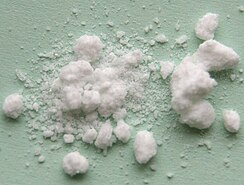Molybdenum hexacarbonyl
|
|
|||
 |
|||
| Names | |||
|---|---|---|---|
|
IUPAC name
Hexacarbonylmolybdenum(0)
|
|||
|
Systematic IUPAC name
Hexacarbonylmolybdenum
|
|||
| Identifiers | |||
|
13939-06-5 |
|||
| 3D model (Jmol) | Interactive image | ||
| ChEBI |
CHEBI:30508 |
||
| ChemSpider |
21428397 |
||
| ECHA InfoCard | 100.034.271 | ||
| EC Number | 237-713-3 | ||
| 3798, 562210 | |||
| MeSH | Hexacarbonylmolybdenum | ||
| PubChem | 98885 | ||
| UN number | 3466 | ||
|
|||
|
|||
| Properties | |||
| C6MoO6 | |||
| Molar mass | 264.01 g·mol−1 | ||
| Appearance | Vivid, white, translucent crystals | ||
| Density | 1.96 g cm−3 | ||
| Melting point | 150 °C (302 °F; 423 K) | ||
| Boiling point | 156 °C (313 °F; 429 K) | ||
| Structure | |||
| Orthogonal | |||
| Octahedral | |||
| 0 D | |||
| Thermochemistry | |||
|
Std enthalpy of
formation (ΔfH |
−989.1 kJ mol−1 | ||
|
Std enthalpy of
combustion (ΔcH |
−2123.4 kJ mol−1 | ||
| Hazards | |||
| Safety data sheet | External MSDS | ||
|
EU classification (DSD)
|
|||
| R-phrases | R26/27/28 | ||
| S-phrases | (S1/2), S36/37/39, S45 | ||
| Related compounds | |||
|
Related compounds
|
Chromium hexacarbonyl |
||
|
Except where otherwise noted, data are given for materials in their standard state (at 25 °C [77 °F], 100 kPa).
|
|||
|
|
|||
| Infobox references | |||
Molybdenum hexacarbonyl (also called molybdenum carbonyl) is the chemical compound with the formula Mo(CO)6. This colorless solid, like its chromium and tungsten analogues, is noteworthy as a volatile, air-stable derivative of a metal in its zero oxidation state.
Mo(CO)6 adopts an octahedral geometry consisting of six rod-like CO ligands radiating from the central Mo atom. A recurring minor debate in some chemical circles concerns the definition of an "organometallic" compound. Usually, organometallic indicates the presence of a metal directly bonded via a M–C bond to an organic fragment, which must in turn have a C–H bond. By this strict definition, Mo(CO)6 is not organometallic.
Mo(CO)6 is prepared by the reduction of molybdenum chlorides or oxides under a pressure of carbon monoxide, although it would be unusual to prepare this inexpensive compound in the laboratory. The compound is somewhat air-stable and sparingly soluble in nonpolar organic solvents.
Mo(CO)6 has been detected in landfills and sewage plants, the reducing, anaerobic environment being conducive to formation of Mo(CO)6.
Mo(CO)6 is a popular reagent in organometallic synthesis because one or more CO ligands can be displaced by other donor ligands. Mo(CO)6, [Mo(CO)3(MeCN)3], and related derivatives are employed as catalysts in organic synthesis for example, alkyne metathesis and the Pauson–Khand reaction.
Mo(CO)6 reacts with 2,2′-bipyridine to afford Mo(CO)4(bipy). UV-photolysis of a THF solution of Mo(CO)6 gives Mo(CO)5(THF).
...
Wikipedia


